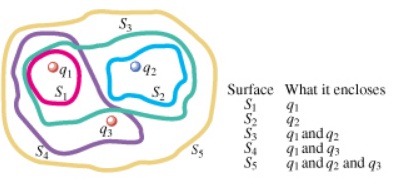Assignment:
Problem 1: A flat sheet of paper of area 0.260m2 is oriented so that the normal to the sheet is at an angle of 61° to a uniform electric field of magnitude 12N/C.
A: Find the magnitude of the electric flux through the sheet.
B: Does the answer to part A depend on the shape of the sheet?
C: For what angle ? between the normal to the sheet and the electric field is the magnitude of the flux through the sheet largest?
D: For what angle ? between the normal to the sheet and the electric field is the magnitude of the flux through the sheet smallest?
E: Explain your answers in parts C and D.
Problem 2: You measure an electric field of 1.28×106 N/C at a distance of 0.157m from a point charge. There is no other source of electric field in the region other than this point charge.
A: What is the electric flux through the surface of a sphere that has this charge at its center and that has radius 0.157 m ?
B: What is the magnitude of the charge?
Problem 3: A point charge of +8.00 μC is located on the x-axis at x= 6.00m , next to a spherical surface of radius x= 5.00m centered at the origin.
A: Calculate the magnitude of the electric field at
B: Calculate the magnitude of the electric field at x= -5.00m .
Problem 4: A solid metal sphere with radius 0.470 m carries a net charge of 0.250nC .
A: Find the magnitude of the electric field at a point 0.114 m outside the surface of the sphere.
B: Find the magnitude of the electric field at a point inside the sphere, 0.114 m below the surface.
Problem 5: Some planetary scientists have suggested that the planet Mars has an electric field somewhat similar to that of the earth, producing a net electric flux of 3.59×1016 N⋅m2/C into the planet's surface.
A: Calculate the total electric charge on the planet.
B: Calculate the magnitude of the electric field at the planet's surface
C: Find the direction of the electric field at the planet's surface.
D: Calculate the charge density on Mars, assuming all the charge is uniformly distributed over the planet's surface.
Problem 6: The three small spheres shown in the figure carry charges q1 = 3.65nC , q2 = -7.80nC , and q3 = 2.75nC.

A: Find the net electric flux through the closed surface S1 shown in cross section in the figure.
B: Find the net electric flux through the closed surface S2 shown in cross section in the figure.
C: Find the net electric flux through the closed surface S3 shown in cross section in the figure.
D: Find the net electric flux through the closed surface S4 shown in cross section in the figure.
E: Find the net electric flux through the closed surface S5 shown in cross section in the figure.
F:Do your answers to parts A through E depend on how the charge is distributed over each small sphere?
G: Why or why not?